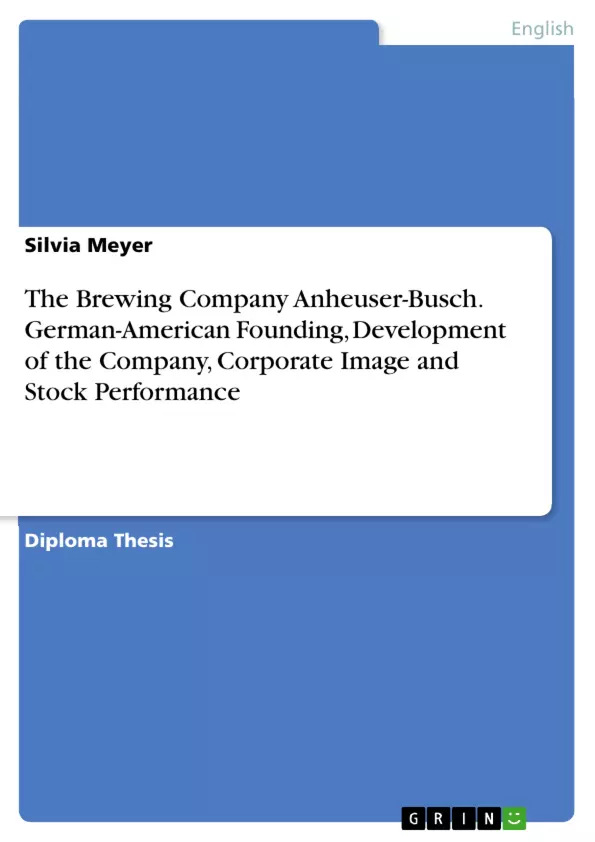The brewing industry is an essential element of the U.S. economy, since beer sales represent 58% of alcohol consumption in the United States. In 2002, the brewing industry had employed more than 850,000 workers and paid $65 billion in taxes. Having obvious competitive advantages over its competitors, Anheuser-Busch is the world's largest and most successful brewer, followed by Miller and Coors.
Since 1857, some extraordinary leaders have guided Anheuser-Busch through prosperous times and through challenges. Anheuser-Busch Companies witnessed the early innovations and inventions of the 19th century, such as mechanical refrigeration, pasteurization and the bottling of beer. Moreover, the company witnessed growing competition, the union movement, the temperamence movement, World War I and prohibition. Despite all those challenges, the company survived and started all over again after repeal, experiencing the new beer business, including more innovations, World War II and changing consumer tastes.
Today, Anheuser-Busch is the leading U.S. brewery, with about 50% shares of national beer sales. Worldwide, the company operates 27 breweries, selling beer in more than 80 countries. Twelve of the breweries are in the United States and fifteen overseas, with fourteen in China and one in Great Britain. In
2002, international beer sales increased by 29.3%, and in 2005, international beer sales even grew by 50.8%.
Besides its beer business, the company owns one of the country's largest manufacturer of aluminum cans and a number of theme parks; it is the world's largest recycler of aluminum beverage containers, and it has interests in malt production, rice milling, label printing, bottle production, transportation services and real estate. Additionally, Anheuser-Busch is engaged in responsibility matters, such as responsible drinking and conservation of the environment. Furthermore, the company is particularly famous for its humorous and rememberable advertisings.
Table of Contents
- Introduction
- Intention
- Structural Composition
- References
- The History of Anheuser-Busch in Consideration of Historical Events and Social Impacts
- The Founders of Anheuser-Busch
- 1857-1920 - Time of Commencement - Barriers and Opportunities
- The Introduction of Budweiser
- Mechanical Refrigeration
- Bottled Beer
- Scientific Brewing
- The Union Movement
- Competition
- Taxes
- The Temperance Movement
- Anheuser-Busch since 1920
- The Challenge of Prohibition
- Home Brewing
- The Call for Repeal
- The New Beer Business
- The Beer Can Revolution
- Second World War
- Lite, Dry, Ice and Non-Alcoholic - The Changing Taste for Beer
- Towards the Twenty-First Century
- Anheuser-Busch Today
- Brand Portfolio
- The Beer Market
- The Domestic Beer Market
- The International Beer Market
- Busch Entertainment Corporation
- Strategic Overview
- Pricing and Quality
- Marketing
- Mergers and Acquisitions
- Exclusive Dealing Contracts
- Distribution Strategies
- Keeping up with the Changing Taste for Beer
- Promoting Responsibility
- Responsible Drinking
- Environmental Commitment
- Human Engagements
- Corporate Governance
- Common Stock Performance
- Perspectives
Objectives and Key Themes
This work examines the history and development of the Anheuser-Busch Company, focusing on its origins, corporate image, and stock performance. It also considers the company's responses to various historical events and societal shifts.- The founding and development of Anheuser-Busch
- The company's evolution within the context of historical events and social impacts
- Anheuser-Busch's strategic responses to industry changes, competition, and consumer tastes
- The role of corporate image and stock performance in the company's success
- Anheuser-Busch's commitment to corporate responsibility and sustainability
Chapter Summaries
The introduction outlines the intention of the work, which is to examine the history of Anheuser-Busch, its development, its corporate image, and its stock performance. The first chapter discusses the company's origins and its founders, along with its early innovations such as mechanical refrigeration, pasteurization, and bottling. Chapter two delves into the company's growth during the late 19th and early 20th centuries, exploring challenges such as the temperance movement, World War I, and prohibition.
Chapter three analyzes the company's post-prohibition era, highlighting the development of new beer business models, the introduction of the beer can, and the company's responses to evolving consumer tastes. This chapter also examines Anheuser-Busch's global expansion, its diverse brand portfolio, and its involvement in various industries such as theme park management and aluminum can manufacturing. Finally, the chapter explores the company's strategic overview, including its pricing and quality policies, marketing strategies, and mergers and acquisitions.
Keywords
This work focuses on the history, development, and corporate performance of Anheuser-Busch. Key concepts include beer production, corporate image, stock performance, historical events, social impacts, strategic responses, market dynamics, consumer tastes, international expansion, corporate responsibility, and sustainability.- Citar trabajo
- Diplom Silvia Meyer (Autor), 2007, The Brewing Company Anheuser-Busch. German-American Founding, Development of the Company, Corporate Image and Stock Performance, Múnich, GRIN Verlag, https://www.grin.com/document/113868



